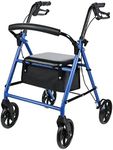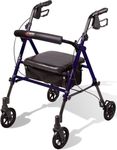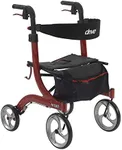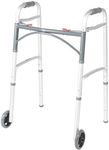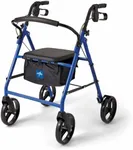Buying Guide for the Best Walkers For Seniors
Choosing the right walker for seniors is all about matching the product to the user's mobility needs, comfort, and lifestyle. Walkers can greatly improve independence and safety, but the best choice depends on how much support is needed, where the walker will be used, and any personal preferences for features. It's important to consider the user's physical strength, balance, and whether the walker will be used mostly indoors, outdoors, or both. Trying out different types and adjusting them for height and comfort can make a big difference in daily use.Type of WalkerThe type of walker refers to the basic design and structure, such as standard walkers (without wheels), two-wheeled walkers, and rollators (with four wheels and often a seat). This is important because it determines the level of support and mobility the walker provides. Standard walkers offer the most stability but require lifting, which can be tiring. Two-wheeled walkers are easier to push but still provide good support. Rollators are best for those who need less support and want to move more quickly, plus they often have seats for resting. To pick the right type, consider the user's balance, strength, and whether they need to rest frequently.
Weight CapacityWeight capacity is the maximum weight the walker can safely support. This is crucial for safety and durability. Walkers are usually divided into standard, heavy-duty, and bariatric categories. Standard walkers typically support up to 250-300 pounds, while heavy-duty or bariatric models can support more. To choose the right one, make sure the user's weight is comfortably below the walker's maximum capacity for safe and reliable use.
AdjustabilityAdjustability refers to how much you can change the height of the walker's handles and sometimes the width. This is important for comfort and proper posture, as a walker that's too high or too low can cause strain or be unsafe. Most walkers have adjustable legs to fit users of different heights. When picking a walker, make sure it can be adjusted so the user's elbows are slightly bent when holding the handles, which is the most ergonomic position.
Weight of the WalkerThe weight of the walker affects how easy it is to lift, move, and transport. Lighter walkers are easier to handle, especially for those with limited strength, but may offer less stability. Heavier walkers can feel sturdier but may be harder to lift over obstacles or into a car. Consider the user's strength and whether they need to frequently transport the walker when choosing the right weight.
Foldability and StorageFoldability refers to whether the walker can be collapsed for storage or transport. This is important for convenience, especially if the walker needs to fit in a car trunk or small space at home. Some walkers fold easily with one hand, while others may require more effort. If the user travels often or has limited storage space, a foldable walker is a good choice.
Brakes and Safety FeaturesBrakes and safety features are especially important for wheeled walkers and rollators. Brakes help control movement and prevent rolling when the user wants to stop or sit. There are different types of brakes, such as loop brakes (squeezed by hand) and push-down brakes (activated by leaning on the handles). Choose a walker with brakes that the user can easily operate, and look for other safety features like non-slip grips and sturdy frames.
Seat and Storage OptionsSome walkers, especially rollators, come with built-in seats and storage baskets or pouches. A seat is useful for users who need to rest frequently, while storage options help carry personal items. If the user will be out for long periods or needs to bring things along, these features can add a lot of convenience and comfort.


